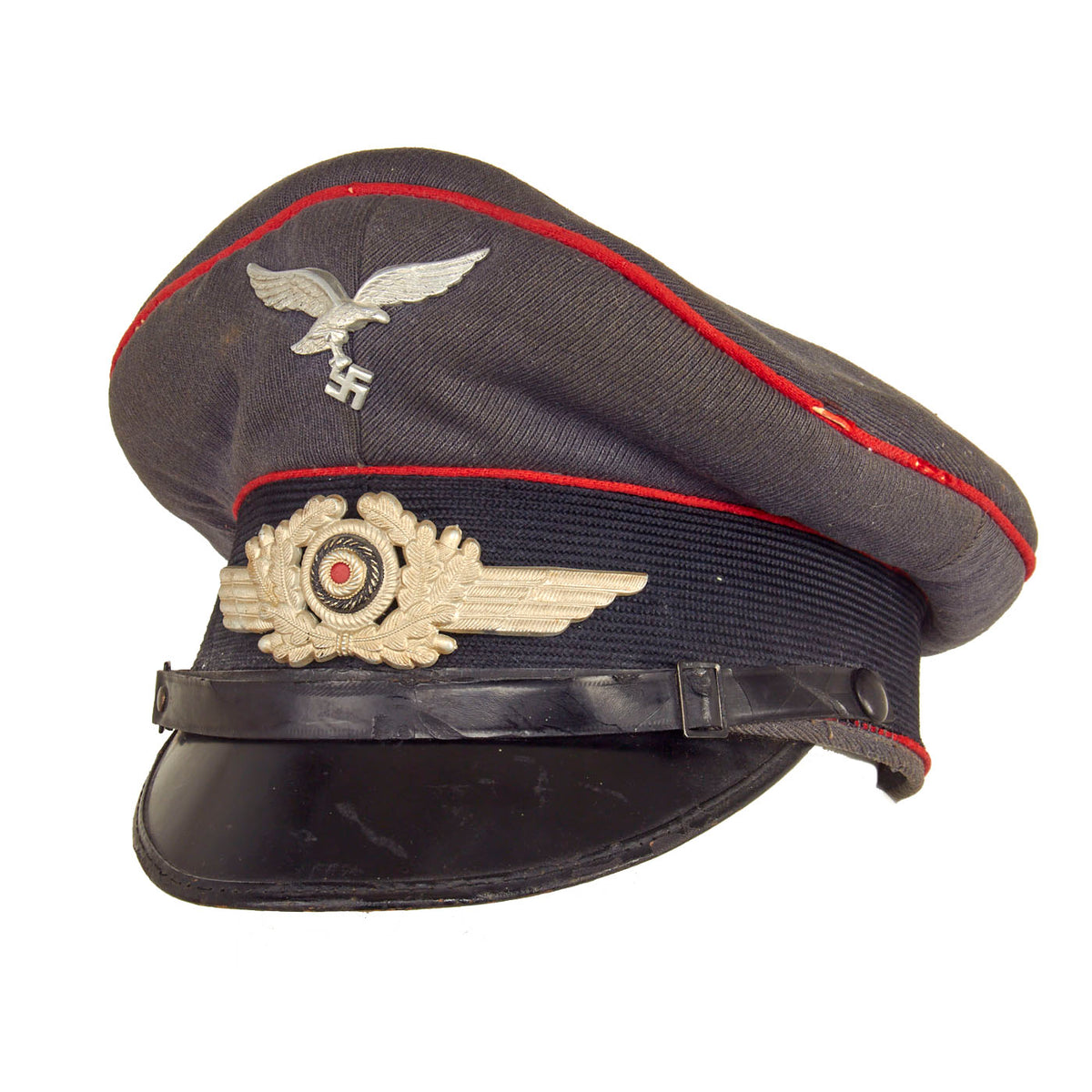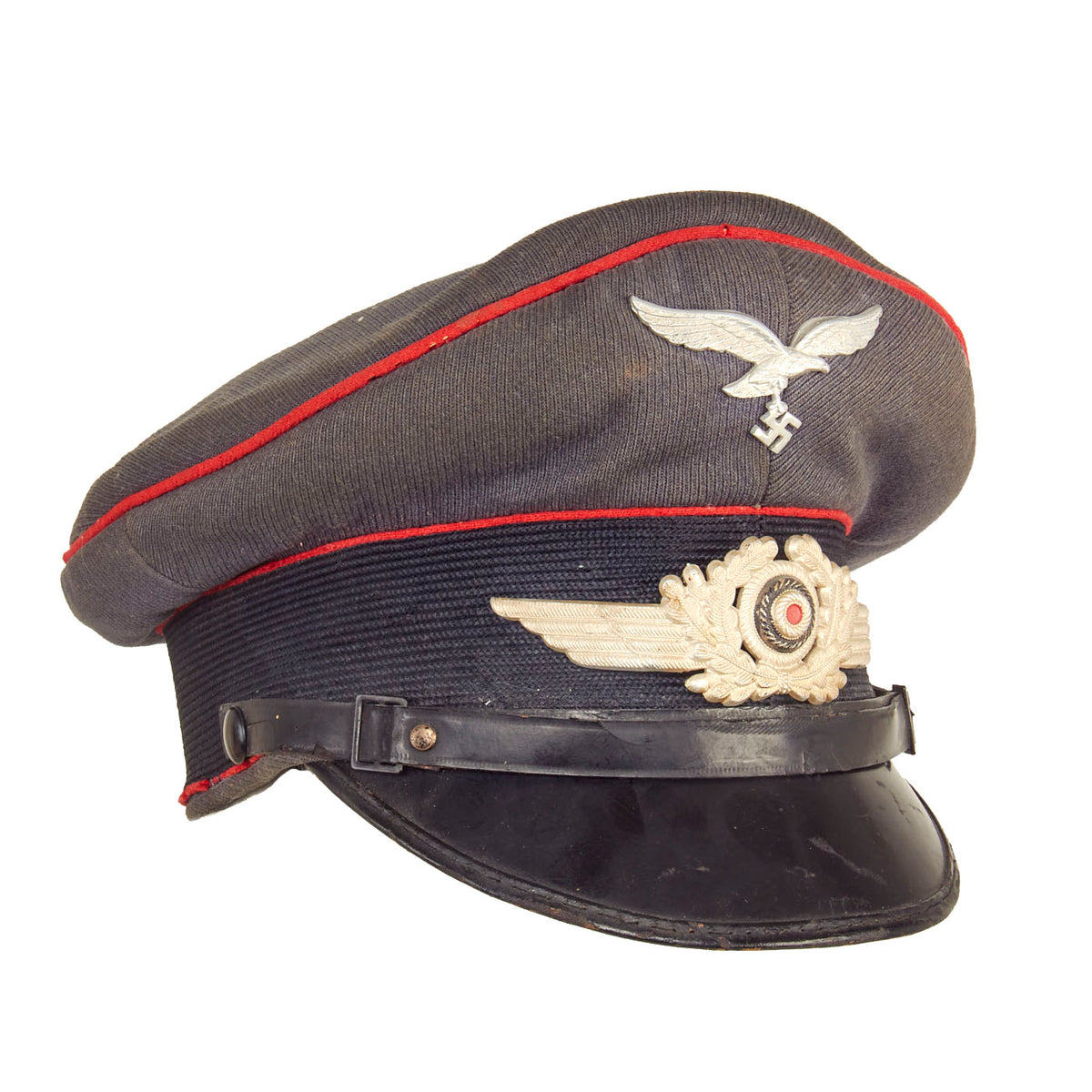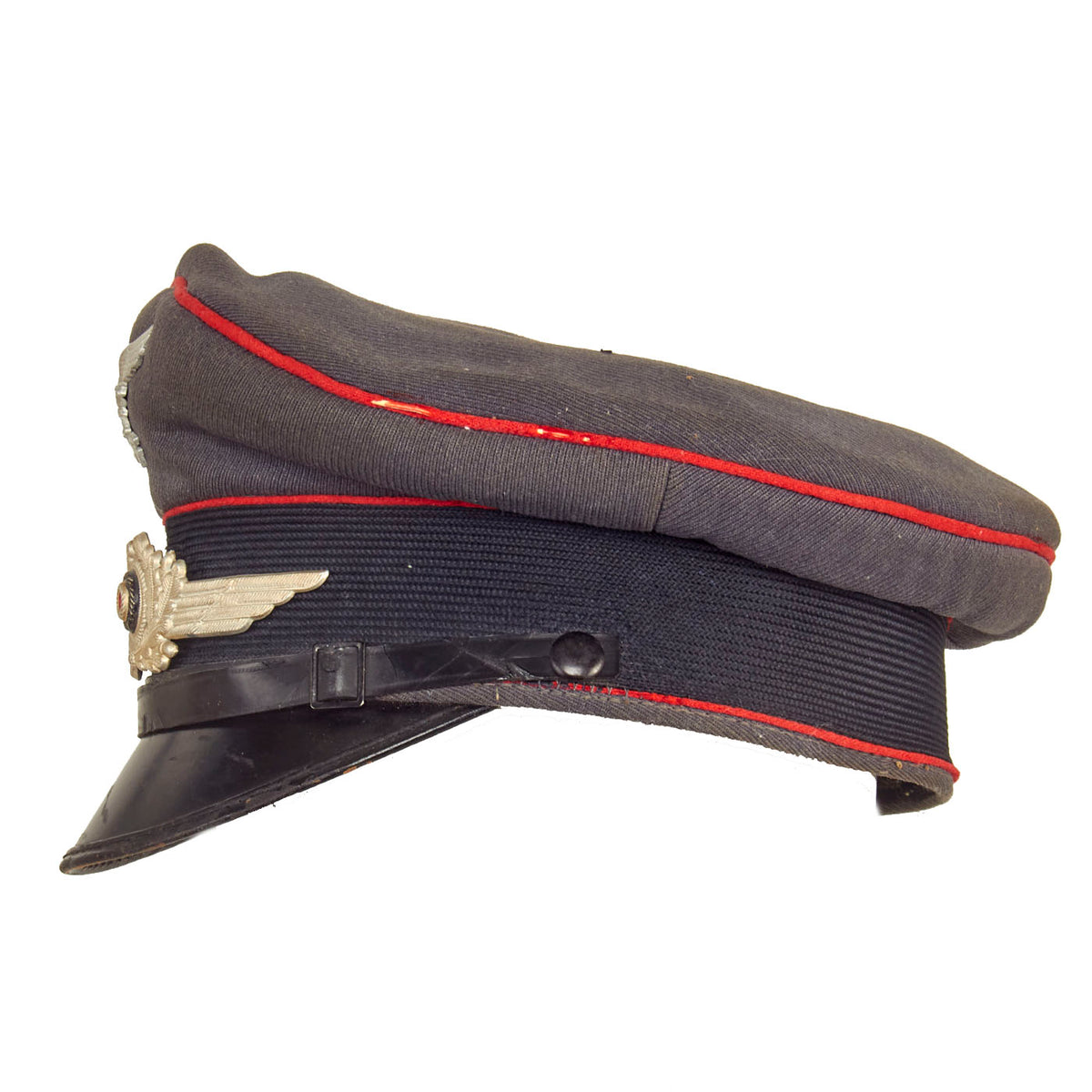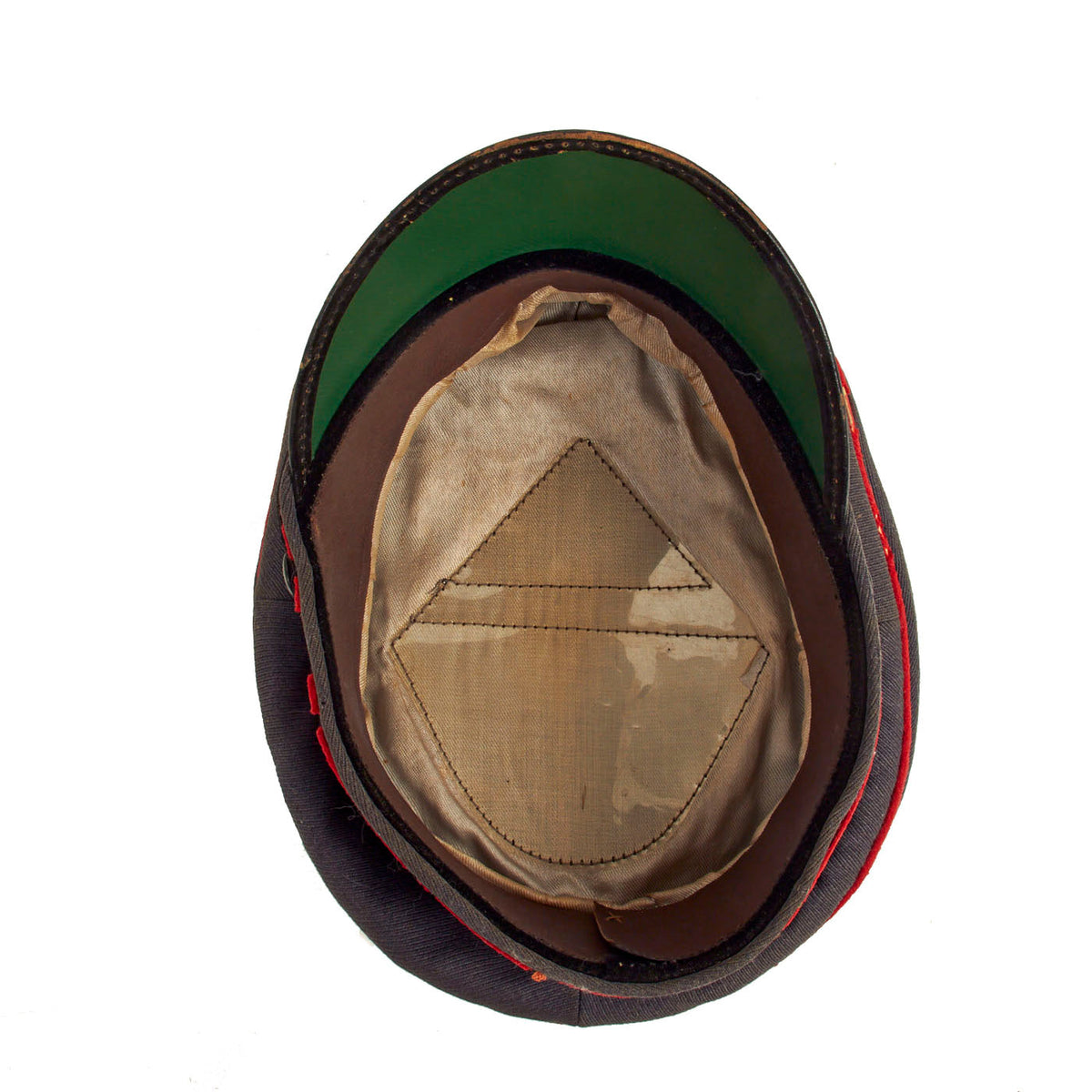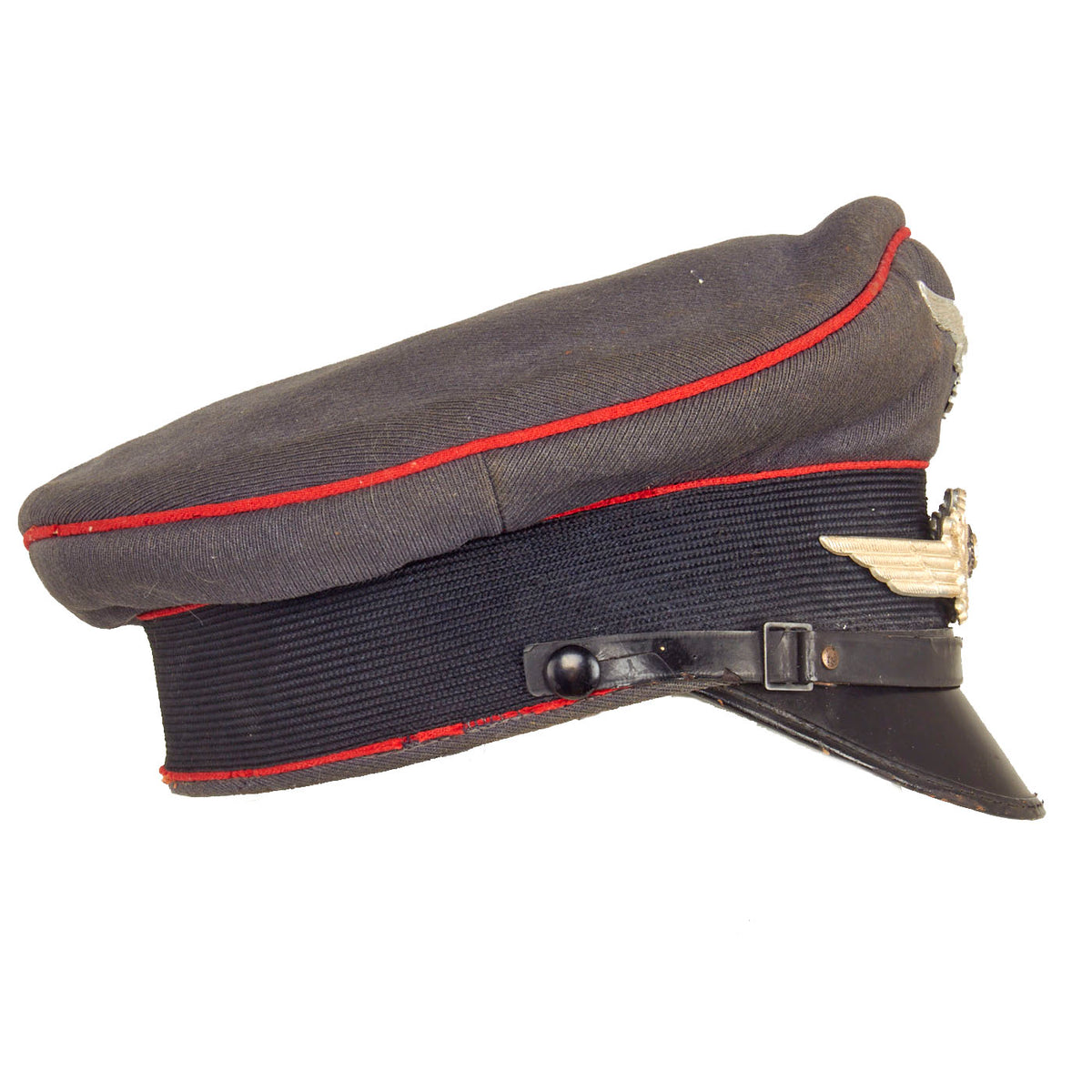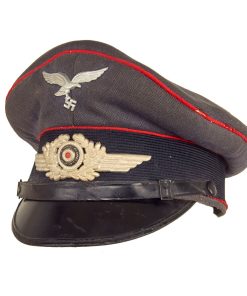Original German WWII Luftwaffe Flakkorps Artillery EM/NCO Schirmmütze Visor Cap Original Items
$ 695,00 $ 208,50
Original Item: Only One available. This is a very nice Luftwaffe Flakkorps (Flak Artillery branch) EM/NCO Schirmmütze (visor cap), a wonderful honest example with a fantastic “saddle-form” crushed shape. It has had the original crown stiffener removed, so the outer edge has that lovely shape that everyone loves. It is fabricated in “whipcord” weave Luftwaffe Fliegerblau (Flyer’s Blue) grey blue wool, with wide black wool cap band, plus three rows of tiefrot (deep red) color piping around the circumference. This is the Luftwaffe Waffenfarbe (corps color) for Anti-aircraft troops and other Artillery.
The peaked visor cap retains a very nice aluminum pin Luftwaffe eagle perched on a swas (hook cross), as well as a centrally mounted aluminum “winged” oak leaf wreath surrounding a tri-color cockade. The black patent leather chin strap and buttons are still present and in very good condition, with some checking and cracking of the leather. The visor is the classic black gloss color with stitched edge trim, made of pressed vulcanfibre.
The wool body is in very good condition, aside from a few moth nips, which mainly affect the red piping. The interior lining is antique white rayon, complete with the original moisture shield. There is no maker marking or size present, but it seems to be around a size 57cm. The sweatband is looks to be made of brown finished leather, which is still quite supple, though the stitching that holds it on is degraded, and it is pulling away at the rear.
This is a very Luftwaffe Flakkorps Artillery EM/NCO peaked visor “crushed” cap, offered in very good used condition. Ready to display!
A flak corps (German: Flakkorps) was a massed anti-aircraft (AA) artillery formation employed by the Luftwaffe for anti-aircraft, antitank, and fire support operations in World War II. A Flakkorps was a flexible organization that was made up of a varying number of AA regiments, brigades, or divisions. A total of six flak corps were organized by Germany during the war. The flak corps, while mainly intended to support ground units with concentrated anti-aircraft fire, in many cases provided also antitank support.
Flak corps did not exist before World War II. Until the end of war Germany eventually organized a total of six flak corps, being numbered I – VI, plus one short-lived special flak corps.
Flak corps I and II were formed on 3 October 1939. They grouped previously existing mobile AA battalions so as to overwhelmingly concentrate their firepower at points of decision on the battlefield. The original two flak corps were used in the Battle of France in 1940, and later inactivated. They were reorganized for the German invasion of Russia and fought for the remainder of the war on the Eastern Front. The I Flak Corps was destroyed at Stalingrad and later formed again.
The III Flak Corps was formed in February 1944 and fought on the Western Front. In total, III Flak Corps entered combat in Normandy with 27 heavy batteries, 26 light batteries and some 12,000 men. During the fighting in Normandy in 1944, the III Flak Corps was motorized although not all authorized vehicles were present. It was eventually destroyed in the Ruhr Pocket in April 1945.
The IV Flak Corps was formed in July 1944 and supported Army Group G on the Western Front until it surrendered in May 1945.
The V Flak Corps was formed in November 1944 and fought in Hungary and Austria.
The VI Flak Corps was formed in February 1945 and fought in northern Germany in support of the 1st Parachute Army.
The flak corps “for special employment” (Flakkorps z.b.V.) was organized in 1945 to control V-weapons.
The German Schirmmütze Visor Cap:
The visor cap (Schirmmütze) was an important part of the headgear worn by German uniformed military, civil, paramilitary and political organizations during the Third Reich. This was the standard cloth headgear worn as a part of the service uniform. Visor caps were worn outdoors as well as indoors, and were often required to be worn by all personnel on duty. Visor caps were made in versions specific to each organization and were often further differentiated through the use of insignia, colored piping, or style of chin cord, to indicate rank, role or branch. The insignia used on these caps ranged from simple stamped metal emblems, to elaborate hand embroidery. Visor caps were issued to enlisted soldiers and NCOs in the military and in some other organizations. Officers had to purchase their own hats, and lower ranks could choose to purchase caps that were of a higher quality than the rather basic, issue examples. The private purchase caps were generally made in very high quality, with fine materials. A wide variety of fabrics were used, from Trikot and doeskin, to heavy wool, or even lightweight white fabric for summer wear. In the military, issue of these caps was generally suspended shortly after the outbreak of the war, but they continued to be worn by some troops until the end of the war.
Fast Shipping with Professional Packaging
Thanks to our longstanding association with UPS FedEx DHL, and other major international carriers, we are able to provide a range of shipping options. Our warehouse staff is expertly trained and will wrap your products according to our exact and precise specifications. Prior to shipping, your goods will be thoroughly examined and securely secured. We ship to thousands clients each day across multiple countries. This shows how we're dedicated to be the largest retailer on the internet. Warehouses and distribution centres can be located throughout Europe as well as the USA.
Note: Orders with more than one item will be assigned a processing date depending on the item.
Before shipping before shipping, we'll conduct a thorough inspection of the items you have ordered. Today, the majority of orders will be delivered within 48 hours. The delivery time will be between 3-7 days.
Returns
The stock is dynamic and we cannot completely manage it because multiple stakeholders are involved, including our factory and warehouse. So the actual stock may alter at any time. It's possible that you may not receive your order once the order has been made.
Our policy is valid for a period of 30 days. If you don't receive the product within 30 days, we are not able to issue a refund or an exchange.
You can only return an item if it is unused and in the same state as the day you received it. You must have the item in its original packaging.
Related products
Uncategorized
Uncategorized
Uncategorized
Uncategorized
Band of Brothers ORIGINAL GERMAN WWII Le. F.H. 18 10.5cm ARTILLERY PIECE Original Items
Uncategorized
Uncategorized
Uncategorized
Uncategorized
Uncategorized
Uncategorized
Uncategorized
Uncategorized
Uncategorized
Uncategorized
Uncategorized
Armoured Fighting Vehicles of the World: AFVs of World War One (Hardcover Book) New Made Items
Uncategorized
Uncategorized
